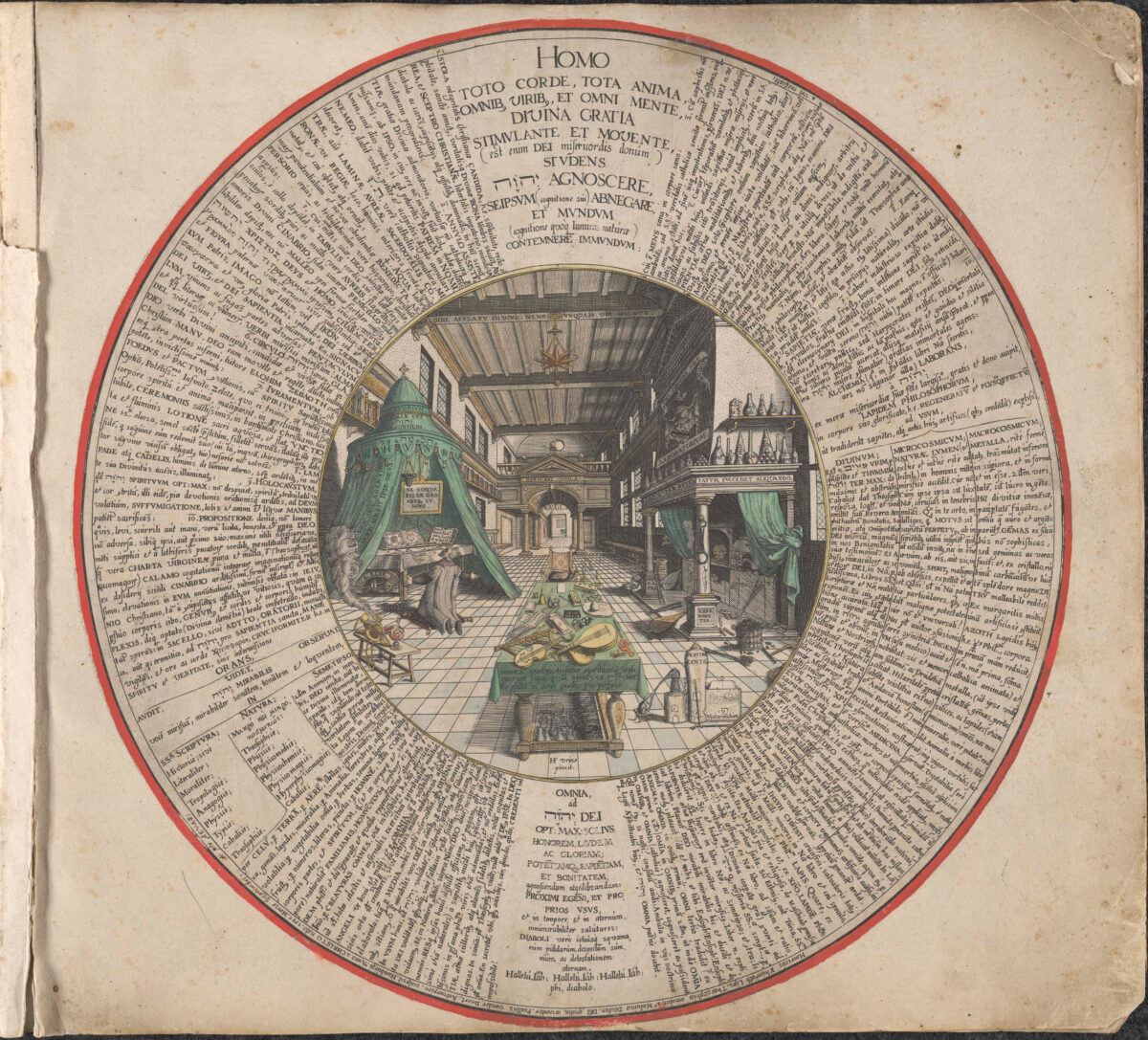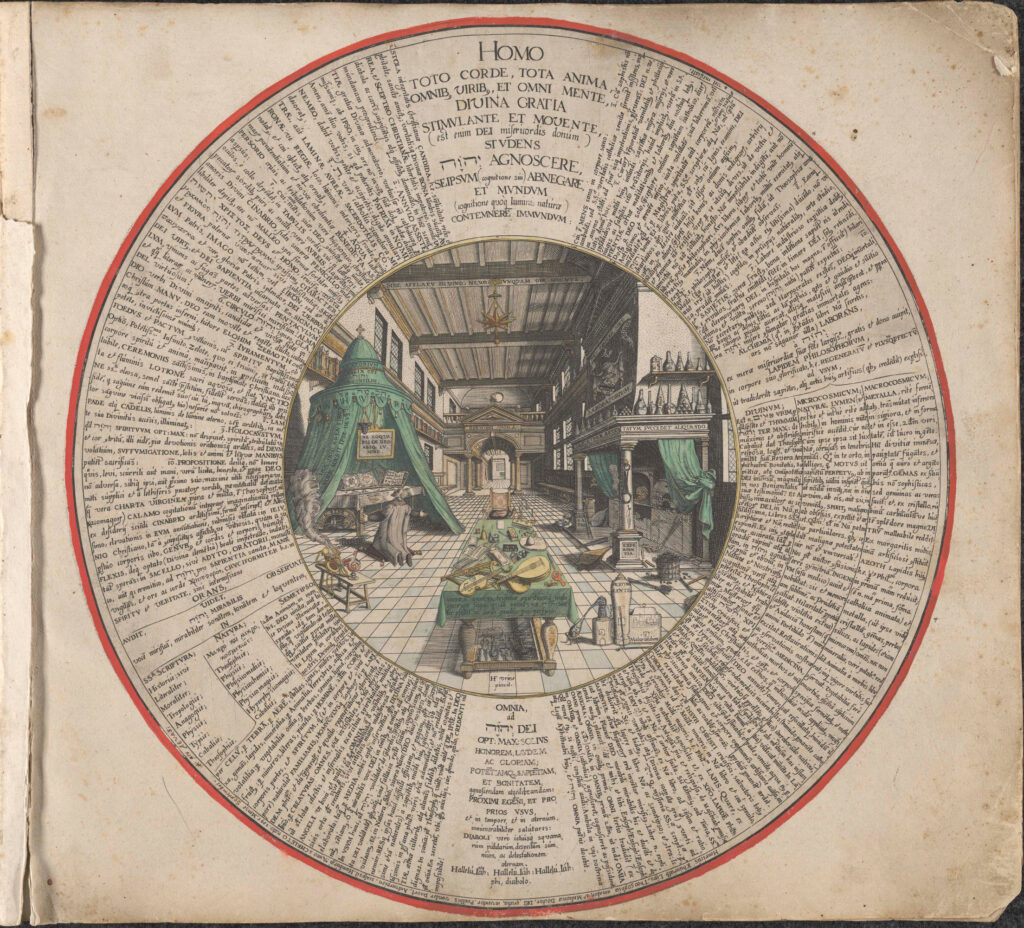Hans Vredeman de Vries, Theosophische Figur des Oratorium & Laboratorium, gezeichnet von Hans Vredeman de Vries und gestochen von Paullus van der Doort, 1595, in: Heinrich Khunrath, Amphitheatrum Sapientiae Aeternae, Hamburg (?) 1595, University of Wisconsin-Madison Special Collections, Sign. Duveen D 897
This circular image of the Oratory-Laboratory first appeared in the rare 1595 edition of Heinrich Khunrath’s Amphitheatre of Eternal Wisdom, as a hand-coloured engraving surrounded by text radiating outwards from the central image like spokes of a wheel. In the 1609 edition, the surrounding text has been removed and placed in the main text as an Isagoge or Introduction to each engraving. Khunrath never discusses the sequence of these images, but comparison of the surviving 1595 copies makes it clear that the four images are in this order: 1) Christ Cruciform; 2) Adam Androgyne, 3) Alchemical Hermaphrodite, and 4) Oratory-Laboratory. While the first three images are 2-dimensional figures, the fourth is 3-dimensional with deep perspective. The implication seems to be that only when the alchemy, magic and Christian Cabala of the previous three images are combined do we get the full ‘reality’ of Khunrath’s Amphitheatre in this visual summation of Khunrath’s entire theosophy and his repeated injunction, Ora et Labora, that is, to pray in the Oratory and work in the Laboratory.
At the top of the image, a roof beam bears a core message in words from Cicero’s De Natura Deorum (On the Nature of the Gods): ‘No one is ever a great man without divine inspiration’. On the left, the Oratory is the realm of the Divine, connected with Christian Cabala, and Divine Magic. In a pavilion labelled Oratorium, we see a table on which rest two books: a psalter, open at Psalm 145:19, declaring ‘YHVH does the Will of them that fear him’; the other bears the Amphitheatre‘s first two circular figures of Christ and Adam. A bearded man, most likely Khunrath himself, kneels, gazing at these images, his arms outstretched in prayer. Below the table are the traditional Vanitas symbols of a skull and hour-glass, suggesting the transcient nature of human life and activity, beneath the words Disce bene mori (‘Learn to Die Well’). Above the table hangs an oil lamp casting light on a tablet bearing the advice Ne loquaris de deo absque lumine (‘Do not speak of God without light’). Not present in the 1595 engraving, but appearing as an extra quote in the 1609 edition, in the smoke rising from the thurible we read Ascendat, ut fumus, oratio, sacrificium deo acceptabile (‘Let Prayer rise like smoke, an acceptable sacrifice to God’).
The opposite side of the engraving is the realm of Creation, the Macrocosm, and shows Khunrath’s Laboratory concerned with the Physico-Chemical investigation of the wonders of Nature, the transmutation of metals, the preparation of chemical medicines and the Philosophers’ Stone. The fireplace with two columns presents the other two sources of knowledge, in addition to divine revelation: Ratio and Experientia (Reason and Experience). Rows of bottles and glasses on the laboratory’s mantelshelf bear substances necessary for both Chrysopoetic (gold-making) and Iatrochemical (chemical-medicinal) alchemy. Khunrath’s coat-of-arms and motto, Nec Temere, Nec Timide (‘Neither rashly, nor timidly’) appear on the chimney-breast.
The table dominating the centre of the engraving is covered with a wide variety of objects, those on the left relating more to the Oratory: ink pot, quill, pencils, notepaper, an alchemical clock; those on the right, balance-scales, a set of weights, tongs or dividers, chopping board and knife, all suggestive of the Laboratory, as are the glass vessels under the table. Directly above the table hangs a star-shaped oil-lamp, with seven branches, relating to the seven archangels and the Oratory, the seven planets of the Ptolemaic cosmos, and seven metals of alchemy in the Laboratory. The four stringed instruments in the foreground relate to the message on the tablecloth: ‘Sacred Music [is] the dispeller (fuga) of sadness and evil spirits; because the Spirit of יהוה [Jehovah] gladly sings in a heart filled with pious joy.’ Behind the table is a portico leading out of the main hall into a room with bed and drapes on the left. On the portico’s architrave we read Dormiens Vigila (‘While Sleeping, Keep Watch’), a phrase indicative of Khunrath’s practice of magical ritual for dream revelation. In total, then, this engraving presents us with an Oratorium, Laboratorium, Auditorium, and Dormitorium.
Peter Forshaw (2021)
Literatur
Brüning 2004, Nr. 677; VD17 1:078059R
Eco, Umberto, Lo Strano Caso della Hanau 1609, Milano 1989; reprinted in idem, La Memoria Vegetale e Altri Scritti di Bibliofilia, Milano 2011; Töllner, Ralf, Der unendliche Kommentar, Untersuchungen zu vier ausgewählten Kupferstichen aus Heinrich Khunraths „Amphitheatrum sapientiae aeternae solius verae“ (Hanau 1609), Hamburg 1991; Bachmann/Hofmeier 1999, S. 157-170; Schmiedehausen, Hans, Alchemie und Theosophie: Jakob Böhmes Denken und ein Kupferstich aus dem Werk des Paracelsisten Heinrich Khunrath, in: Die Morgenröte bricht an: Jakob Böhme, naturnaher Mystiker und Theosoph, hg. von Martin Leichle, Karlsruhe 1999, S. 76-99; Szulakowska 2000, S. 79-152; Forshaw 2006; Laube, Stefan, Verdichtung, Fragmentierung und Verdrängung. Die Theatrum-Metapher in der Wissenstradition des Pietismus, in: Dimensionen der Theatrum-Metapher in der Frühen Neuzeit. Ordnung und Repräsentation von Wissen, hg. von Flemming Schock, Oswald Bauer und Ariane Koller (metaphorik.de, Heft 14), Hannover 2008, S. 55-88>; Forshaw 2010; Schmidt-Biggemann 2013, Kap. 1, S. 1-60; Lüthi, Roland, Ein typisches Unikat. Das Exemplar von Heinrich Khunraths „Amphitheatrum Sapientiae Aeternae“ (Hanau 1609) in der ETH-Bibliothek Zürich, in: Libarium 2013, S. 99-107; Laube, Stefan, Kat. Nr. 20, Akat. Goldenes Wissen 2014, S. 230; Gilly, Carlos, Das „Amphitheatrum Sapientiae aeternae“ von Heinrich Khunrath, in: Heinrich Khunrath „Amphitheatrum Sapientiae Aeternae – Schauplatz der ewigen allein wahren Weisheit“. Vollständiger Reprint des Erstdrucks von [Hamburg] 1595 und des zweiten und letzten Drucks Hanau 1609, hg. von Carlos Gilly, Anja Hallacker, Hanns-Peter Neumann und Wilhelm Schmidt-Biggemann, Stuttgart-Bad Cannstatt 2014, S. 133-181; Hallacker, Anja, Das Bild-Text-Verhältnis in Heinrich Khunraths „Amphitheatrum Sapientiae aeternae“, in: ebd., S. 25-40; Schmidt-Biggemann, Wilhelm, Der Text und die Bilder. Das ikonologische Programm von Khunraths „Amphitheatrum Sapientiae Aeternae“, in: ebd., S. 41-132; Purš, Ivo, Perspective, Vision and Dream: Notes on the Plate „Oratory-Laboratory“ in Heinrich Khunrath’s Amphitheatrum sapientiae aeternae, in: Latin Alchemical Literature of Czech Provenance, hg. von Tomáš Nejeschleba und Jiří Michalík, Prag 2015, S. 50-89; Wels 2017, bes. S. 33ff.
Online-Exemplare (verschiedene Publikationsjahre) University of Wisconsin-Madison Special Collections (koloriert), Houghton Library (Harvard University), BPH Amsterdam, HAB Wolfenbüttel, ULB Sachsen-Anhalt, GNM Nürnberg

